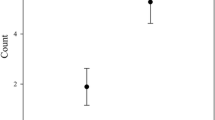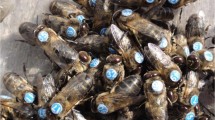Abstract
Artificially reared larvae are an ideal model for experiments involving brood diseases or testing pesticides. Because conditions during larval development can influence the general performance of adult honeybees, we created an evaluation method for the viability of artificially reared honeybees. We compared the flight performance of honeybees artificially reared in the laboratory with that of their sisters naturally reared in the colony. Fresh and dry weight, wing surface area, flight speed, flight duration, and distance covered by honeybee workers after feeding defined amounts of different sugar solutions were measured during tethered flight in a roundabout. Our results demonstrate that after artificial rearing, adult honeybees at the natural age of flight exhibit similar flight performances to their naturally reared sisters. The naturally reared honeybees, however, attained higher maximum flight speeds when fed energy-rich 2molar glucose solution.
Zusammenfassung
Honigbienen können im Labor künstlich aufgezogen werden. Dazu werden Larven aus Brutwaben in Plastikschälchen übersiedelt und die umfassende Brutpflege der Ammenbienen im Stock durch wenige definierte Fütterungen ersetzt sowie die Temperatur und die Luftfeuchtigkeit genau reguliert. Diese Methode ermöglicht es nun standardisierte Untersuchungen über die Auswirkungen von Chemikalien wie Pflanzenschutzmitteln oder Infektionen mit Krankheitserregern durchzuführen, ohne gesamte Völker in Kontakt mit den Schadstoffen oder Erregern zu bringen. Wir haben erstmals die Qualität von Arbeiterinnen die mit Hilfe dieser Technik aufgezogen wurden anhand ihrer Flugleistung in einem Karussell analysiert und mit der Leistung ihrer natürlich aufgezogener Schwestern verglichen (Abb. 1). Die durchschnittliche Fluggeschwindigkeit im Karussell betrug etwa 1 m/s und die maximale Fluggeschwindigkeit 1,4 m/s (Tab. I). Diese unterschieden sich bei künstlich und natürlich aufgezogenen Bienen nicht, wenn 10 μL einer 1-Molaren Glukoselösung gefüttert werden. Bei Fütterung von hochenergetischer 2-Molarer Glukoselösung flogen die Kontrollbienen, nicht aber die künstlich aufgezogenen, schneller als mit 1-Molarer Glukoselösung nämlich mit 1,2 m/sec Durchschnittsgeschwindigkeit. Die Maximalgeschwindigkeit (1,6 m/s) der Kontrollbienen war bei dieser Fütterung auch höher als die der künstlich aufgezogenen (1,4 m/s, Tab. I).
Ein guter Indikator für die Qualität der Larvalernährung ist das Gewicht der Arbeiterinnen, und wir fanden, dass das Trockengewicht bei den von uns künstlich aufgezogenen Bienen niedriger als bei den Kontrollbienen war. Wir konnten auch zeigen, dass dieser Unterschied vor allem in einem leichteren Thorax, in dem sich die Flugmuskulatur befindet, der künstlich aufgezogenen Bienen begründet ist (Abb. 2). Außerdem fanden wir schwache Unterschiede in den Flächen der Vorder- und Hinterflügel: wiederum waren die der künstlich aufgezogenen etwas kleiner als die der Kontrollbienen.
Unsere Ergebnisse zeigen, dass künstlich aufgezogene Bienen das Alter von Sammlerinnen (über 20 Tage) erreichen können. Trotz eines etwas leichteren Thoraxgewichtes, in dem sich die Flugmuskulatur befindet, und etwas kleinerer Flügel zeigten sie annähernd ähnliche Flugleistungen wie natürlich aufgezogene Honigbienen.
Similar content being viewed by others
References
Al-Tikrity W.S., Benton A.W., Hillman R.C., Clarke W.W. (1972) The relationship between the amount of unsealed brood in honeybee colonies and their pollen collection, J. Apic. Res. 11, 9–12.
Allen M.D., Jeffree E.P. (1956) The influence of stored pollen and of colony size on the brood rearing of honeybees, Ann. Appl. Biol. 44, 649–656.
Aupinel P., Fortini D., Dufour H., Tasei J.N., Michaud B., Odoux J.F., Pham-Delègue M.H. (2005) Improvement of artificial feeding in a standard in vitro method for rearing Apis mellifera larvae, Bull. Insect. 58, 107–111.
Brødsgaard C.J., Ritter W., Hansen H., Brodsgaard H.F. (2000) Interactions among Varroa jacobsoni mites, acute paralysis virus, and Paenibacillus larvae larvae and their influence on mortality of larval honeybees in vitro, Apidologie 31, 543–554.
Daly H.V., Danka R.G., Hoelmer K., Rinderer T.E., Buco S.M. (1995) Honey bee morphometrics: linearity of variables with respect to body size and classification tested with European worker bees reared by varying ratios of nurse bees, J. Apic. Res. 34, 129–145.
Eischen F.A., Rothenbuhler W.C., Kulincevic J.M. (1982) Length of life and dry weight of worker honeybees reared in colonies with different worker-larva ratios, J. Apic. Res. 21, 19–25.
Frisch K. von, Lindauer M. (1955) Über die Fluggeschwindigkeit der Bienen und über ihre Richtungsweisung bei Seitenwind, Naturwissenschaften 42, 377–385.
Gmeinbauer R., Crailsheim K. (1993) Glucose utilisation during flight of honeybee workers, drones and queens, J. Insect Physiol. 39, 959–967.
Harrison J. (1986) Caste-specific changes in honeybee flight capacity, Physiol. Zool. 59, 175–187.
Harrison J.F., Fewell J.H. (2002) Environmental and genetic influences on flight metabolic rate in the honey bee, Apis mellifera, J. Comp. Biochem. Physiol. A 133, 323–333.
Harrison J.F., Taylor O.R. Jr, Hall H.G. (2005) The flight physiology of reproductives of Africanized, European, and hybrid honeybees (Apis mellifera), Physiol. Biochem. Zool. 78, 153–62.
Haydak M.H. (1970) Honey bee nutrition, Annu. Rev. Entomol. 15, 143–156.
Heinrich B. (1980) Mechanisms of Body-Temperature Regulation in Honeybees, Apis mellifera II: Regulation of Thoracic Temperature at High Air Temperatures, J. Exp. Biol. 85, 73–87.
Hellmich R.L., Rothenbuhler W.C. (1986) Relationship between different amounts of brood and the collection and use of pollen by the honeybee (Apis mellifera), Apidologie 17, 13–20.
Hepburn H.R., Radloff S.E., Fuchs S. (1999) Flight machinery dimensions of honeybees, Apis mellifera, J. Comp. Physiol. B 169, 107–112.
Herbert E.W., Sylvester H.A., Vandenberg J.D., Shimanuki H. (1988) Influence of nutritional stress and the age of adults on the morphometrics of honey bees (Apis mellifera L.), Apidologie 19, 221–230.
Herold R.C. (1965) Development and ultrastructural changes of sarcosomes during honey bee flight muscle development, Dev. Biol. 12, 269–286.
Hersch M.I., Crewe R.M., Hepburn H.R., Thompson P.R., Savage N. (1978) Sequential development of glycolytic competence in muscles of worker honeybees, Comp. Biochem. Physiol. B 61, 427–431.
Hrassnigg N., Crailsheim K. (1999) Metabolic rates and metabolic power of honeybees in tethered flight related to temperature and drag (Hymenoptera: Apidae), Entomol. Gen. 24, 23–30.
Hrassnigg N., Brodschneider R., Fleischmann P.H., Crailsheim K. (2005) Unlike nectar foragers, honeybee drones (Apis mellifera) are not able to utilize starch as fuel for flight, Apidologie 36, 547–557.
Imdorf A., Rickli M., Kilchenmann V., Bogdanov S., Wille H. (1998) Nitrogen and mineral constituents of honey bee worker brood during pollen shortage, Apidologie 29, 315–325.
Jay S.C. (1964) Starvation studies of larval honey bees, Can. J. Zool. 42, 455–462.
Kunert K., Crailsheim K. (1988) Seasonal changes in carbohydrate, lipid and protein content in emerging worker honeybees and their mortality, J. Apic. Res. 27, 13–21.
Lindauer M. (1952) Ein Beitrag zur Frage derArbeitsteilung im Bienenstaat, Z. Vergl. Physiol. 34, 299–345.
Mattila H.R., Otis G.W. (2006) The effects of pollen availability during larval development on the behaviour and physiology of spring-reared honey bee, Apidologie 37, 533–546.
Moritz B., Crailsheim K. (1987) Physiology of protein digestion in the midgut of the honeybee (Apis mellifera L.), J. Insect. Physiol. 33, 923–931.
Nachtigall W., Hanauer-Thieser U., Mörz M. (1995) Flight of the honey bee VII: metabolic power versus flight speed relation, J. Comp. Physiol. B 165, 484–489.
Neukirch A. (1982) Dependence of the life span of the honeybee (Apis mellifera) upon flight performance and energy consumption, J. Comp. Physiol. B 146, 35–40.
OEPP/EPPO (2001) Test methods for evaluating the side effects of plant protection products on honeybees, Bull. OEPP/EPPO 31, 323–330.
OEPP/EPPO (2003) Environmental risk assessment scheme for plant protection products, Bull. OEPP/EPPO 33, 141–145.
Pankiw T., Page RE., Fondrk M.K. (1998) Brood pheromone stimulates pollen foraging in honey bees (Apis mellifera), Behav. Ecol. Sociobiol. 44, 193–198.
Rembold H., Lackner B. (1981) Rearing of honeybee larvae in vitro: Effect of yeast extract on queen differentiation, J. Apic. Res. 20, 165–171.
Riessberger-Gallé U., Vollmann J., Brodschneider R., Aupinel P., Crailsheim K. (2008a) Improvement in the pupal development of artificially reared honeybee larvae, Apidologie 39, 595.
Riessberger-Gallé U., Vollmann J., Crailsheim K. (2008b) Dynamics of body weight in honeybee larvae: artificially versus naturally raised, Apidologie 39, 595–596.
Roberts S.P., Elekonich M.M. (2005) Muscle biochemistry and the ontogeny of flight capacity during behavioral development in the honey bee, Apis mellifera, J. Exp. Biol. 208, 4193–4198.
Schmickl T., Crailsheim K. (2001) Cannibalism and early capping: strategies of honeybee colonies in times of experimental pollen shortages, J. Comp. Physiol. A 187, 541–547.
Schmickl T., Crailsheim K. (2002) How honeybees (Apis mellifera L.) change their broodcare behavior in response to non-foraging conditions and poor pollen conditions, Behav. Ecol. Sociobiol. 51, 415–425.
Suarez R.K. (2000) Energy metabolism during insect flight: Biochemical design and physiological performance, Physiol. Biochem. Zool. 73, 765–771.
Tautz J. (2007) Phänomen Honigbiene, Spektrum Akademischer Verlag, München.
Tautz J., Maier S., Groh C., Rössler W., Brockmann A. (2003) Behavioral performance in adult honey bees is influenced by the temperature experienced during their pupal development, Proc. Natl. Acad. Sci. USA 100, 7343–7347.
Vandenberg J.D., Shimanuki H. (1987) Technique for rearing worker honeybees in the laboratory, J. Apic. Res. 26, 90–97.
Vollmann J., Stabentheiner A., Kovac H. (2004) Die Entwicklung der Endothermie bei Honigbienen (Apis mellifera carnica Pollm.), Mitt. Dtsch. Ges. Allg. Angew. Entomol. 14, 467–470.
Wang D.I. (1965) Growth rates of young queen and worker honeybee larvae, J. Apic. Res. 4, 3–5.
Wittmann D., Engels W. (1981) Development of test procedures for insecticide-induced brood damage in honeybees, Mitt. Dtsch. Ges. Allg. Angew. Entomol. 3, 187–190.
Author information
Authors and Affiliations
Corresponding author
Additional information
Manuscript editor: Klaus Hartfelder
Rights and permissions
About this article
Cite this article
Brodschneider, R., Riessberger-Gallé, U. & Crailsheim, K. Flight performance of artificially reared honeybees (Apis mellifera). Apidologie 40, 441–449 (2009). https://doi.org/10.1051/apido/2009006
Received:
Revised:
Accepted:
Issue Date:
DOI: https://doi.org/10.1051/apido/2009006




